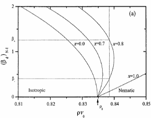Molecular dynamics simulations of nematic phases formed by cyano-biphenyl dimers
AG Vanakaras, DJ Photinos, Liquid Crystals 45 (13-15), 2184-2196, (2018).
 Abstract: Molecular dynamics simulations of selected members of the cyano-biphenyl (CB) series of dimers (CBnCB) have been set up using atomistic detail for the description of the alkyl spacer and coarse-grained representation of the CB end-segments. Detailed results are presented for the CB7CB dimers, showing an isotropic fluid phase and two nematic phases. The positional and orientational correlation functions extracted from the simulations are used to elucidate the structure of the low-temperature nematic phase. Polar molecular ordering is clearly identified along a direction undergoing helical twisting at right angles to the helical axis, with a constant pitch of about of 8 nm. The local ordering of the various molecular segments is calculated and found to be in excellent agreement with experimental NMR measurements. Key findings of the simulation are shown to be correctly predicted by the theoretical model of the polar-twisted nematic (NPT) phase [A.G. Vanakaras, D.J. Photinos, Soft Matter. 12 (2016) 2208–2220]. The complete failure of the usual twist bend model (NTB) to account for these findings is demonstrated.
Abstract: Molecular dynamics simulations of selected members of the cyano-biphenyl (CB) series of dimers (CBnCB) have been set up using atomistic detail for the description of the alkyl spacer and coarse-grained representation of the CB end-segments. Detailed results are presented for the CB7CB dimers, showing an isotropic fluid phase and two nematic phases. The positional and orientational correlation functions extracted from the simulations are used to elucidate the structure of the low-temperature nematic phase. Polar molecular ordering is clearly identified along a direction undergoing helical twisting at right angles to the helical axis, with a constant pitch of about of 8 nm. The local ordering of the various molecular segments is calculated and found to be in excellent agreement with experimental NMR measurements. Key findings of the simulation are shown to be correctly predicted by the theoretical model of the polar-twisted nematic (NPT) phase [A.G. Vanakaras, D.J. Photinos, Soft Matter. 12 (2016) 2208–2220]. The complete failure of the usual twist bend model (NTB) to account for these findings is demonstrated.
 An international school on “Modeling and Computer Simulation Methods for Dendrimers”
An international school on “Modeling and Computer Simulation Methods for Dendrimers” 

